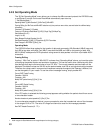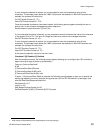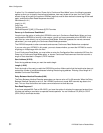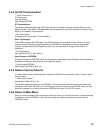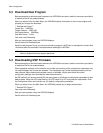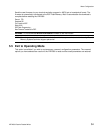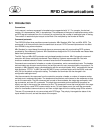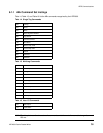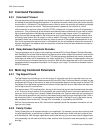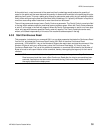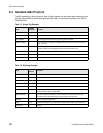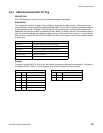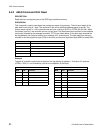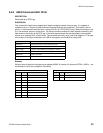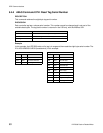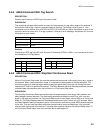RFID Communications
57 LRP2000 Passive Reader/Writer
6.2 Command Parameters
6.2.1 Command Timeout
All single-tag and multi-tag commands have a timeout value that is used to specify the time the controller
will attempt to complete the specified operation. The absolute minimum timeout value that can be issued to
the controller is 1 millisecond. The absolute maximum time for which the controller will attempt to complete
a command is just over one minute. The timeout parameter is passed to the controller in units of
milliseconds with a maximum value of 65,534 (FFFEH) milliseconds. A timeout value of 0 will generate a
syntax error. Thirty milliseconds is the shortest recommended timeout and should only be used for single-
tag command applications. Multiple-tag commands will require longer timeout values. For applications
where the time that the tags spend in the field must be short, tests should be performed to ensure that a
sufficiently large timeout value is chosen in order to read all of the tags. A longer timeout value does not
necessarily mean that a command will take any longer to execute. If the tags being addressed are in the
field, it only represents the period of time (in milliseconds) the unit will attempt to execute the command. If
the tags are present, the response time to execute the command will be the same whether the timeout is
100 ms or 10,000 ms.
6.2.2 Delay Between Duplicate Decodes
The one parameter that is unique to the single-tag command 0DH is Delay Between Duplicate Decodes.
After Start/Stop Continuous Read is started, any tag that comes within range of the antenna is read and the
requested data from the tag is sent to the host. This delay parameter represents the number of seconds
that a tag must remain out of range before it is read a second time. This delay is implemented to allow you
to limit the volume of information sent by the controller. With this delay parameter set to 00H, the controller
repeatedly sends the requested information until the tag is out of range. The maximum allowable value is
60 (3CH) seconds.
6.3 Multi-tag Command Parameters
6.3.1 Tag Repeat Count
The Tag Repeat Count allows you to limit the volume of information sent by the controller when you are
using the multi-tag Continuous Read commands, 83H and 8DH. After Continuous Read is initiated, any tag
that comes within range of the antenna is read, and the requested data from the tag is sent to the host. The
Tag Repeat Count parameter represents the number of other tags that must be read before the data from
the first tag is sent for a second time.
This feature uses a FIFO overflow buffer; first tag in will be the first tag id to be discarded when the buffer
is full. Every time a tag is read its ID is compared to the current buffer to see if it has been read before. The
value you use for the tag count is directly related to the buffer size. Tags are read once upon entering the
field, and read a second time only after they have been reset by leaving and re-entering the field. Once a
tag reenters the field, it is read again and compared to the buffer. If the tag ID is not in the buffer, the tag
data requested is sent to the host. If the tag ID is in the buffer, it is ignored by the LRP2000.
With this Count parameter set to 00H, the controller repeatedly sends the requested information until the
tags are out of range.
6.3.2 Family Codes
Family Codes allow you to organize the tags in your application. For example, you can use one family code
for pallet identification, a second family code for case-level identification, and a third family code for item-
level identification. With the tags organized by family code this way, you could read a box of tagged items
on the assembly line with item level family codes, and then write the product code and quantity to a case
level tag.



